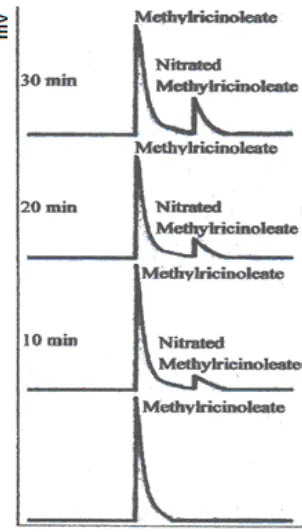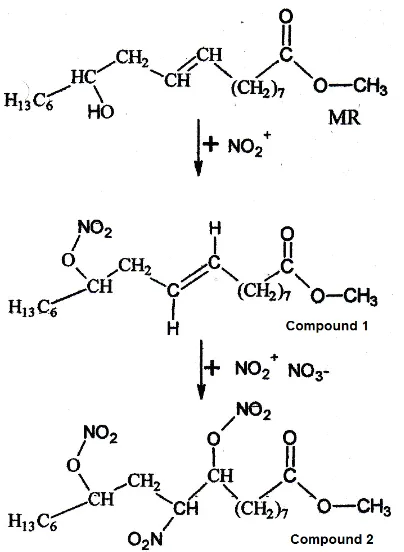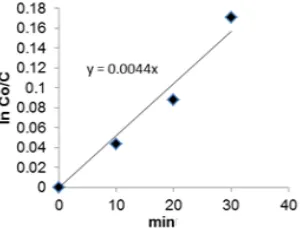Abdullah et al.
* Corresponding author. Tel/Fax : +62-511-4772428/4773868 Email address : [email protected]
THE OPTIMUM REACTION TIME, ACTIVATION ENERGY AND FREQUENCY FACTOR
OF METHYL RICINOLEATE NITRATION
Abdullah1,2,*, Triyono2, Wega Trisunaryanti2, and Winarto Haryadi2
1
Department of Chemistry, Faculty of Mathematic and Natural Sciences, Lambung Mangkurat University, Indonesia
2
Department of Chemistry, Faculty of Mathematics and Natural Science, Universitas Gadjah Mada, Sekip Utara, Yogyakarta 55281
Received January 2, 2013; Accepted March 21, 2013
ABSTRACT
Determination of the optimum reaction time, activation energy (Ea) and frequency factor (A) of methyl ricinoleate nitration has been done. The nitration was conducted with the mole ratio of methyl ricinoleate to HNO3 of
1:15. The reaction was conducted at temperatures of 29 and 64 °C with a variation of reaction time for 10, 20, 30, 60, 90, 120, and 150 min. Determination of activation energy and frequency factor was performed in a temperature of 29, 33, 38, 44, 49, 57 and 64 °C. The results showed that the optimum reaction time is 90 min. The activation energy (Ea) and frequency factor (A) was 44.5 kJ/mol and 4.780 x 103 sec-1, respectively.
Keywords: optimum reaction time; activation energy; frequency factor; nitration of methyl ricinoleate
ABSTRAK
Penentuan waktu reaksi optimum, energi aktivasi (Ea) dan faktor frekuensi (A) pada nitrasi metil risinolat telah
dilakukan. Nitrasi dilakukan dengan perbandingan mol metil risinolat terhadap HNO3 adalah sebesar 1:15. Reaksi
dilakukan pada temperatur 29 and 64 °C dengan variasi waktu reaksi selama 10; 20, 30, 60, 90, 120, dan 150 menit. Penentuan energi aktivasi dan faktor frekuensi dilakukan pada temperatur 29, 33, 38, 44, 49, 57 and 64 °C. Hasil penelitian menunjukkan bahwa waktu reaksi optimum adalah 90 menit. Energi aktivasi (Ea) dan faktor frekuensi (A) masing-masing adalah 44,5 kJ/mol dan 4,780 x 103 detik-1.
Kata Kunci: waktu reaksi optimum; energi aktivasi; faktor frekuensi; nitrasi metil risinolat
INTRODUCTION
Research in order to find additives to improve cetane number in diesel oil is more attractive. This happens due to lower quality of the crude oil that is characterized by an increase in specific gravity, sulfur content, carbon content of residual fraction, a light fraction and a decrease in cetane index [1]. Crude oil with low quality when processed will certainly impact on the quality of diesel oil. Therefore, diesel oil required an additive to improve its quality [2].
Types of additives that widely used is an organic nitrate compounds. One type additives derived from this class is 2-ethylhexyl nitrate or better known as the EHN [3-4]. This compound is produced from propene derivative obtained from the cracking of petroleum and flammable [4-5]. Relation to this material, the researchers attempted to find alternative utilization triglycerides compound or fatty acids as raw materials [6-10]. The utilization of these compounds were based on its safety to use, highly abundant availability and renewable.
In an attempt to produce nitrate compounds made from fatty acids, Poirier et al. [6] and Adnan [7] initially undertaken the hydration reaction at the double bond of the carbon atoms (C=C), followed by reduction to obtain alcohol compound. The alcohol was then nitrated using HNO3. Meanwhile, Suppes et al. [5] conducted nitration directly on the C=C double bond without hydration and reduction in the first step. Thus the results of nitrated compounds were not only had nitrate group (–NO3), but it also a nitro group (–NO2). While Rabello et al. [10] chosen a shorter way by transesterification of castor oil (Ricinus communis), where the compound already had an alcohol group in the nitration required. Nitration of methyl ricinoleate could occur at the hydroxyl group, forming methyl ricinoleate nitrate. However, because there is a C=C double bond as well, an addition reaction produces another compound is possible to occur.
Abdullah et al.
limited. This article reported data on the optimum reaction time, activation energy and frequency factor of nitration of methyl ricinoleate. The data of the order of the reaction, the reaction rate constants and reaction rates had been reported [11]. The result showed that order of the reaction was pseudo first-order and the rate constant at 29 °C was 6.667 x 10-4 (sec-1). While the reaction rates were 3.736 x 10-5, 2.471 x 10-5 and 1.724 x 10-5 M/sec for initial concentration of 0.375; 0.325 and 0.250 M, respectively.
Based on the previous results, this article reported data the optimum reaction time, activation energy and frequency factor in order to completed kinetics data of methyl ricinoleate nitration.
EXPERIMENTAL SECTION
Materials
The materials used in this study were methyl ricinoleate, nitric acid, acetic acid anhydride, diethyl ether, anhydrous Na2SO4, and distilled water.
Instrumentation
The instruments in research were three neck round bottom flask, thermometer, magnetic stirrer, heater, Gas Chromatography (GC, Hewlett Packard 5890 Series II) and Fourier Transform Infrared spectroscopy (FTIR, Shimadzu Prestige 21).
Procedure
Nitration of methyl ricinoleate
Nitric acid (3 mL) and acetic acid anhydride (4 mL) was successively and slowly put in three neck round bottom flask equipped with thermometer, cooler and magnetic stirrer equipped with a heater. The magnetic stirrer was operated on gently run (200 rpm). The temperature was set to get the desired reaction temperature. After the temperature reach a constant, 1 mL methyl of ricinoleate was added quickly. After the reaction had carried out for t min, the reaction was stopped and continued with neutralization process.
The reaction was terminated by adding the mixture into 200 mL of ice water and 20 mL diethyl ether in separating funnel. The bottom layer was separated and the upper layer (diethyl ether) was washed with distilled water until neutral. Then the upper layer was dried with anhydrous Na2SO4 and allowed to stand for 24 h. The results of the nitration products were analyzed by GC and FTIR.
Fig 1. Chromatograms of methyl ricinoleate (MR) and nitrated methyl ricinoleate (Nitrated MR) at 10, 20 and 30 min
Determination of the optimum reaction time
Determination of the optimum reaction time was carried out by varying the reaction time of 10, 20, 30, 60, 90, 120 and 150 min. The temperature reaction was set at 29 °C and 64 °C. Determination of optimum reaction time was based on the concentration of the products that observed by GC.
Determination of activation energy and frequency factor
Determination of activation energy and frequency factor was carried out by varying the temperature at 29–64°C, a mole ratio of methyl ricinoleate to HNO3 was 1:15. Determining the optimum ratio was based on the results of previous studied [9].
RESULT AND DISCUSSION
Nitration of Methyl ricinoleate (MR)
Abdullah et al.
3 3 2 3 2 3 3 2 3 3 2 5 2 5 3 2 3 2
- +
3 2 3 2
HNO + (CH CO) O CH COONO + CH COOH
CH COONO + HNO CH COOH + N O
N O + (CH CO) O CH COONO
CH COONO CH COO + NO
Fig 2. Spectra FTIR of nitrated methyl ricinoleate and methyl ricinoleate
Fig 3. Formation of NO2+ from reaction of HNO3 with acetic acid anhydride
Fig 4. Formation of compound 1 and 2 from from methyl ricinoleate
Fig 5. Chromatogram of product of nitration methyl ricinoleate during 150 min at 29 °C
Furthermore, the results were analyzed by FTIR to ensure that the new compounds derived from nitration of methyl ricinoleate. According to Suppes et al. [5], the nitrate group as a result of nitrated fatty acid ester compound was characterized by a sharp absorption at wavenumber region of 1650 (cm-1). Meanwhile, according to Wade [12] a group of nitrate (–NO3) was characterized by the appearance of a sharp absorption at wavenumber region of 1650–1500 cm-1. FTIR spectra in Fig. 2 showed the existence of a sharp absorption at 1627 cm-1, which come from N–O stretching of nitrate group.
Fig. 2 showed the absorption extends to 3440 cm-1 region of the stretching vibration of O–H bond. The
absorption indicated the existence of hydroxyl group (–OH) in methyl ricinoleate. The absorption spectra were also present in the area of 2924, 2854, 856 and 725 cm-1 as a result of the stretching vibration of C–H bond of the alkyl group. Sharp absorption in the region in 1735 cm-1 as a result of the C=O stretching vibration and the absorption at 1172 cm-1 area come from the C–O bond, which both absorption indicated the ester group. In the spectra of nitrated methyl ricinoleate absorption at 3440 cm-1 region still appeared. It could conclude that product of nitration still contained methyl ricinoleate (reactant). According to Suppes and Dasari [13], the formation of nitrate group initiated by the formation of nitronium ion (NO2+) derived from the reaction of HNO3 with acetic anhydride was shown in Fig. 3.
Abdullah et al.
Fig 6. Graph the percentage of products (C1 and C2) versus reaction temperature for 10, 20 and 30 min
Fig 8. Ln C versus time graphs in the determination of k for temperatures of 29 °C
Fig 7. Graph the percentage of products (C1 and C2) versus reaction time for the reaction at 29 and 64 °C
Fig 9. Graph of ln k against 1/T in determination of Ea
As shown in Fig. 4, the nitration of the compound 1 also involved NO3-. Nitration in which involving HNO3 and acetic anhydride also produced N2O5 in their reaction steps as noted in Fig. 1. This compound could also be used as a reagent in the nitration as be conducted by Suppes et al. [5]. The experiment showed that product of nitration contains nitro (–NO2) and nitrate (–NO3) groups compounds.
The Optimum Reaction Time
At first nitration performed for 10, 20 and 30 min at a temperature of 29, 33, 38, 44, 49, 57 and 64 °C. Fig. 6 showed that nitration at temperatures of 29 and 33 °C only produces compound 1 (C1), although the reaction has been run for 30 min. The nitration carried out at a temperature of 38 °C produced compound 2 (C2). In the nitration where temperatures were higher, the formation of compound 2 occurred at earlier time. Thus, to get a product that contains only C1, the nitration might be performed at 29 or 33 °C.
Nitration at temperatures of 64 °C performed for 30 min produced C2 as the major product. Thus, if a lot of C2 was desired, the nitration must be performed at 64 °C. In this experiment, nitration at temperatures above 64 °C was not carried out because the nitration resulted in a very rapid increase of heat. This leads to the kinetics cannot be observed.
Further nitration performed at longer reaction times, i.e. 60, 90, 120 and 150 min, in which the reaction was carried out at a temperature of 29 and 64 °C (Fig. 7). The reaction temperature at 29 °C (room temperature) was chosen because the reaction at that temperature no need additional energy (heat), so making it more efficient. In addition, nitration at 29 °C only produced C1. While nitration at 64 °C had produced C2 as major component in the product.
Fig. 7 shown that nitration at a temperature of 29 °C also produced C2 if the reaction has held 120 min minimally. Therefore to get the nitration products only contain of C1, then the nitration carried at 29 °C for about 90 min. The nitration conditions were then used in subsequent experiments. Results of nitration with C2 as the major component (the largest concentration) occurred in the nitration at 64 °C, carried out for 150 min.
Activation Energy and Frequency Factor on Nitration of Methyl ricinoleate
Reaction rate constant was determined by the relationship between ln C versus reaction time, where C was the concentration of residual methyl ricinoleate. Fig. 8 presented graph of ln C versus time for different reaction temperatures.
Abdullah et al.
constant (k) for the nitration at a temperature 29 °C was equal to 7.333 x 10-5 sec-1. In the same way k values obtained for the nitration at 33 and 38 °C, respectively were 9.833 x 10-5 and 1.467 x 10-4 sec-1. Based on the value of k, it could be seen that the value of k increased with the increase of reaction temperature. Furthermore, the data was used to create a graph of ln k against 1/T to obtain the activation energy (Ea).
Based on the graph in Fig. 7 the -slope of 6696.3 K, Ea of 44.5 kJ/mol, and frequency factor (A) of 4.780 x 103 sec-1 was obtained.
CONCLUSION
Nitration of methyl ricinoleate at 29 °C for 90 min (the optimum reaction time) facilitated the production of methyl ricinoleate nitrate. The activation energy (Ea) and frequency factor (A) were 44.5 kJ/mol and 4.780 x 103 sec-1, respectively.
ACKNOWLEDGEMENT
The author would like to thank the Higher Education DP2M who gave financial support through Grants Doctoral program 2013.
REFERENCES
1. Stratiev, D., Rinkov, R., Petkov, K and Stanulov, 2010, Pet.Coal, 52, 1, 35-43.
2. Ren, Y., Huang, Z.H., Jiang, D.M., Liu, W.L.B., and Wang, X.B., 2008, Proc. Inst. Mech. Eng. Pt. D J.
Automobile Eng., 222, 1077–1087.
3. Serena, F.S., Nicolau, E., Favreau, G., Jouanneau, Y., and Marchal, R., 2007, Biodegradation, 20, 1, 85–95.
4. Petrochem Energy SA, 2010, Safety Data Sheet of 2-Ethylhexylnitrate, MSDS PCE-2950, Postsrasse, Switzerland.
5. Suppes, G.J., Heppert, J.A. and Mason, M.H.J.R., 2001, Process for Production Cetane Improver
From Triglyserides, United States Patent
Application Publication., 2001/0037598 A1.
6. Poirier, M.A., Steere, D.E. and Krogh, J.A., 1995,
Cetane Improver Compositions Comprising
Nitrated Fatty Acid Derivatives, United States
Patent, 5, 454, 842.
7. Nasikin, M., Arbianti, R., and Aziz, A., 2002,
Makara J. Technol. Ser., 6, 82-88,
8. Adnan, R., 2002, Synthesis of Cetane Improver Additive from Palm Oil by Method of Nitration through Initial Reaction Using a Grignard Reagent, Thesis, Faculty of Chemical Engineering UI, Jakarta.
9. Canoira, L., Alcántara, L., Torcal, S., Tsiouvaras, N., Lois, E. and Korres, D.M., 2007, Fuel, 86, 7-8, 965–971
10. Rabello, Klootz, C.R, Siqueira, Galvao, B., De Menezez and Bazerra, R., 2009, Method for Production of Cetane-Index Improvement Additive
for Diesel Oil, European Patent Application,
EP2050810.
11. Abdullah, Triyono, Wega, T and Winarto, H., 2012,
Indo. J. Chem., 12, 2, 126–130.
12. Wade, Jr. L.G., 2006, Organic Chemistry, 6th ed., Pearson Education Inc., USA.
13. Suppes, G.J. and Dasari, M.A., 2003, Ind. Eng.


